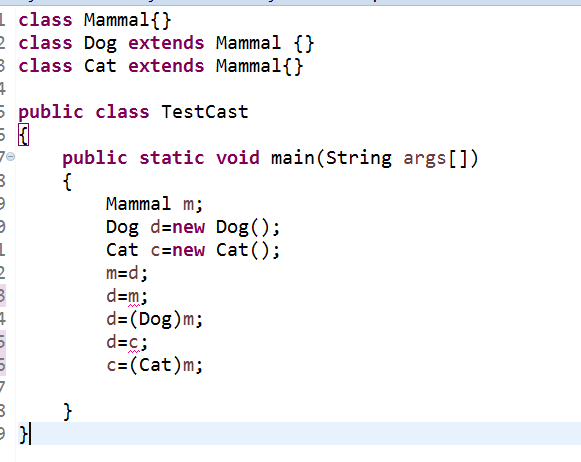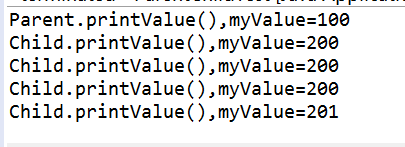1.继承条件下的构造方法调用
package parent;
class Grandparent
{
public Grandparent()
{
System.out.println("GrandParent Created.");
}
public Grandparent(String string)
{
System.out.println("GrandParent Created.String:" + string);
}
}
class Parent extends Grandparent
{
public Parent()
{
//super("Hello.Grandparent.");
System.out.println("Parent Created");
//super("Hello.Grandparent.");
}
}
class Child extends Parent
{
public Child()
{
System.out.println("Child Created");
}
}
public class TestInherits
{
public static void main(String args[])
{
Child c = new Child();
}
}

结论:通过super调用基类构造方法,必须是子类构造方法中的第一个语句。也就是说,子类的构造方法在运行之前,必须调用父类的构造方法。因为子类必须继承父类的变量和方法。如果不先给父类中的变量赋值,则子类中从父类继承的变量没有赋值。所以不能反过来先给父类赋值。
2.类型转换
下列语句哪一个将引起编译错误?为什么?哪一个会引起运行时错误?为什么? m=d; d=m; d=(Dog)m; d=c; c=(Cat)m; 先进行自我判断,得出结论后,运行TestCast.java实例代码,看看你的判断是否正确。
d=m,d=c运行时将会报错。因为m是父类对象,d是子类对象。将父类对象转化成子类对象,必须进行强制转换。而d和c是两个互不相干的类对象,所以不能将d赋值给c.

3.子类父类拥有同名的方法
1. 左边的程序运行结果是什么? 2. 你如何解释会得到这样的输出? 3. 计算机是不会出错的,之所以得 到这样的运行结果也是有原因的, 那么从这些运行结果中,你能总 结出Java的哪些语法特性?
public class ParentChildTest {
public static void main(String[] args) {
Parent parent=new Parent();
parent.printValue();
Child child=new Child();
child.printValue();
parent=child;
parent.printValue();
parent.myValue++;
parent.printValue();
((Child)parent).myValue++;
parent.printValue();
}
}
class Parent{
public int myValue=100;
public void printValue() {
System.out.println("Parent.printValue(),myValue="+myValue);
}
}
class Child extends Parent{
public int myValue=200;
public void printValue() {
System.out.println("Child.printValue(),myValue="+myValue);
}
}

结论:
(1)子类对象可以赋值给父类的对象。父类进行子类强制转换可以赋值给子类的对象。
(2)子类能覆盖父类,但是父类中的变量的值是不改变的,访问父类中的变量时可用super来访问,反之则一直被子类覆盖。父类被覆盖时,对父类中的变量进行操作时,父类中的变量改变,但输出时仍输出覆盖父类的子类的变量。
(3)(child)Parent.myValue++,这时改变的将是覆盖父类的子类。